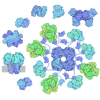+ Open data
Open data
- Basic information
Basic information
| Entry | Database: PDB / ID: 8v3o | ||||||
|---|---|---|---|---|---|---|---|
| Title | CCP5 in complex with Glu-P-peptide 1 transition state analog | ||||||
 Components Components |
| ||||||
 Keywords Keywords | HYDROLASE/INHIBITOR / carboxypeptidase deglutamylation branch glutamate removal microtubule / HYDROLASE / HYDROLASE-INHIBITOR complex | ||||||
| Function / homology |  Function and homology information Function and homology informationtubulin-glutamate carboxypeptidase / protein deglutamylation / protein side chain deglutamylation / protein branching point deglutamylation / C-terminal protein deglutamylation / Post-chaperonin tubulin folding pathway / Cilium Assembly / Microtubule-dependent trafficking of connexons from Golgi to the plasma membrane / Carboxyterminal post-translational modifications of tubulin / Intraflagellar transport ...tubulin-glutamate carboxypeptidase / protein deglutamylation / protein side chain deglutamylation / protein branching point deglutamylation / C-terminal protein deglutamylation / Post-chaperonin tubulin folding pathway / Cilium Assembly / Microtubule-dependent trafficking of connexons from Golgi to the plasma membrane / Carboxyterminal post-translational modifications of tubulin / Intraflagellar transport / Sealing of the nuclear envelope (NE) by ESCRT-III / Formation of tubulin folding intermediates by CCT/TriC / Gap junction assembly / Prefoldin mediated transfer of substrate to CCT/TriC / Kinesins / COPI-independent Golgi-to-ER retrograde traffic / Assembly and cell surface presentation of NMDA receptors / COPI-dependent Golgi-to-ER retrograde traffic / Recycling pathway of L1 / Hydrolases; Acting on peptide bonds (peptidases); Metallocarboxypeptidases / RHO GTPases activate IQGAPs / Hedgehog 'off' state / intercellular bridge / COPI-mediated anterograde transport / Activation of AMPK downstream of NMDARs / metallocarboxypeptidase activity / Mitotic Prometaphase / EML4 and NUDC in mitotic spindle formation / MHC class II antigen presentation / tubulin binding / Recruitment of NuMA to mitotic centrosomes / HSP90 chaperone cycle for steroid hormone receptors (SHR) in the presence of ligand / Resolution of Sister Chromatid Cohesion / Translocation of SLC2A4 (GLUT4) to the plasma membrane / RHO GTPases Activate Formins / cerebral cortex development / PKR-mediated signaling / structural constituent of cytoskeleton / microtubule cytoskeleton organization / neuron migration / HCMV Early Events / Aggrephagy / The role of GTSE1 in G2/M progression after G2 checkpoint / mitotic spindle / Separation of Sister Chromatids / mitotic cell cycle / extracellular vesicle / microtubule cytoskeleton / midbody / defense response to virus / microtubule / GTPase activity / GTP binding / proteolysis / extracellular exosome / zinc ion binding / metal ion binding / nucleus / cytoplasm / cytosol Similarity search - Function | ||||||
| Biological species |  Homo sapiens (human) Homo sapiens (human) | ||||||
| Method |  X-RAY DIFFRACTION / X-RAY DIFFRACTION /  SYNCHROTRON / SYNCHROTRON /  MOLECULAR REPLACEMENT / Resolution: 2.3 Å MOLECULAR REPLACEMENT / Resolution: 2.3 Å | ||||||
 Authors Authors | Chen, J. / Zehr, E.A. / Gruschus, J.M. / Szyk, A. / Liu, Y. / Tanner, M.E. / Tjandra, N. / Roll-Mecak, A. | ||||||
| Funding support |  United States, 1items United States, 1items
| ||||||
 Citation Citation |  Journal: Nature / Year: 2024 Journal: Nature / Year: 2024Title: Tubulin code eraser CCP5 binds branch glutamates by substrate deformation. Authors: Jiayi Chen / Elena A Zehr / James M Gruschus / Agnieszka Szyk / Yanjie Liu / Martin E Tanner / Nico Tjandra / Antonina Roll-Mecak /   Abstract: Microtubule function is modulated by the tubulin code, diverse posttranslational modifications that are altered dynamically by writer and eraser enzymes. Glutamylation-the addition of branched ...Microtubule function is modulated by the tubulin code, diverse posttranslational modifications that are altered dynamically by writer and eraser enzymes. Glutamylation-the addition of branched (isopeptide-linked) glutamate chains-is the most evolutionarily widespread tubulin modification. It is introduced by tubulin tyrosine ligase-like enzymes and erased by carboxypeptidases of the cytosolic carboxypeptidase (CCP) family. Glutamylation homeostasis, achieved through the balance of writers and erasers, is critical for normal cell function, and mutations in CCPs lead to human disease. Here we report cryo-electron microscopy structures of the glutamylation eraser CCP5 in complex with the microtubule, and X-ray structures in complex with transition-state analogues. Combined with NMR analysis, these analyses show that CCP5 deforms the tubulin main chain into a unique turn that enables lock-and-key recognition of the branch glutamate in a cationic pocket that is unique to CCP family proteins. CCP5 binding of the sequences flanking the branch point primarily through peptide backbone atoms enables processing of diverse tubulin isotypes and non-tubulin substrates. Unexpectedly, CCP5 exhibits inefficient processing of an abundant β-tubulin isotype in the brain. This work provides an atomistic view into glutamate branch recognition and resolution, and sheds light on homeostasis of the tubulin glutamylation syntax. | ||||||
| History |
|
- Structure visualization
Structure visualization
| Structure viewer | Molecule:  Molmil Molmil Jmol/JSmol Jmol/JSmol |
|---|
- Downloads & links
Downloads & links
- Download
Download
| PDBx/mmCIF format |  8v3o.cif.gz 8v3o.cif.gz | 116.4 KB | Display |  PDBx/mmCIF format PDBx/mmCIF format |
|---|---|---|---|---|
| PDB format |  pdb8v3o.ent.gz pdb8v3o.ent.gz | 85.9 KB | Display |  PDB format PDB format |
| PDBx/mmJSON format |  8v3o.json.gz 8v3o.json.gz | Tree view |  PDBx/mmJSON format PDBx/mmJSON format | |
| Others |  Other downloads Other downloads |
-Validation report
| Summary document |  8v3o_validation.pdf.gz 8v3o_validation.pdf.gz | 446.9 KB | Display |  wwPDB validaton report wwPDB validaton report |
|---|---|---|---|---|
| Full document |  8v3o_full_validation.pdf.gz 8v3o_full_validation.pdf.gz | 451 KB | Display | |
| Data in XML |  8v3o_validation.xml.gz 8v3o_validation.xml.gz | 23.1 KB | Display | |
| Data in CIF |  8v3o_validation.cif.gz 8v3o_validation.cif.gz | 31 KB | Display | |
| Arichive directory |  https://data.pdbj.org/pub/pdb/validation_reports/v3/8v3o https://data.pdbj.org/pub/pdb/validation_reports/v3/8v3o ftp://data.pdbj.org/pub/pdb/validation_reports/v3/8v3o ftp://data.pdbj.org/pub/pdb/validation_reports/v3/8v3o | HTTPS FTP |
-Related structure data
| Related structure data |  8v3mC  8v3nC  8v3pC 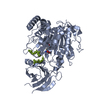 8v3qC 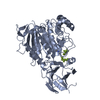 8v3rC 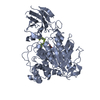 8v3sC  8v4kC  8v4lC  8v4mC C: citing same article ( |
|---|---|
| Similar structure data | Similarity search - Function & homology  F&H Search F&H Search |
- Links
Links
- Assembly
Assembly
| Deposited unit | 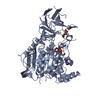
| ||||||||
|---|---|---|---|---|---|---|---|---|---|
| 1 |
| ||||||||
| Unit cell |
|
- Components
Components
-Protein / Protein/peptide , 2 types, 2 molecules AI
| #1: Protein | Mass: 59170.668 Da / Num. of mol.: 1 / Mutation: E516A,residues 339-424 replaced with a SGSGG loop Source method: isolated from a genetically manipulated source Source: (gene. exp.)  Homo sapiens (human) / Gene: AGBL5, CCP5 / Plasmid: pFastBac / Details (production host): His_MBP_Asn10_TEV / Cell line (production host): Sf9 / Production host: Homo sapiens (human) / Gene: AGBL5, CCP5 / Plasmid: pFastBac / Details (production host): His_MBP_Asn10_TEV / Cell line (production host): Sf9 / Production host:  References: UniProt: Q8NDL9, Hydrolases; Acting on peptide bonds (peptidases); Metallocarboxypeptidases, tubulin-glutamate carboxypeptidase |
|---|---|
| #2: Protein/peptide | Mass: 1905.682 Da / Num. of mol.: 1 / Mutation: One of the glutamates replaced with BIX / Source method: obtained synthetically / Source: (synth.)  Homo sapiens (human) / References: UniProt: Q13885 Homo sapiens (human) / References: UniProt: Q13885 |
-Non-polymers , 4 types, 143 molecules 
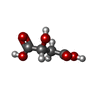





| #3: Chemical | ChemComp-ZN / | ||||
|---|---|---|---|---|---|
| #4: Chemical | | #5: Chemical | ChemComp-K / | #6: Water | ChemComp-HOH / | |
-Details
| Has ligand of interest | Y |
|---|---|
| Has protein modification | Y |
-Experimental details
-Experiment
| Experiment | Method:  X-RAY DIFFRACTION / Number of used crystals: 1 X-RAY DIFFRACTION / Number of used crystals: 1 |
|---|
- Sample preparation
Sample preparation
| Crystal | Density Matthews: 2.26 Å3/Da / Density % sol: 45.49 % |
|---|---|
| Crystal grow | Temperature: 294 K / Method: vapor diffusion, hanging drop Details: 0.15 M DL-Malic acid, pH7.0, 0.1 M imidazole, pH7.0, 16% PEG MME 550 |
-Data collection
| Diffraction | Mean temperature: 93 K / Serial crystal experiment: N |
|---|---|
| Diffraction source | Source:  SYNCHROTRON / Site: SYNCHROTRON / Site:  ALS ALS  / Beamline: 8.2.1 / Wavelength: 1 Å / Beamline: 8.2.1 / Wavelength: 1 Å |
| Detector | Type: DECTRIS EIGER X 9M / Detector: PIXEL / Date: May 17, 2022 |
| Radiation | Protocol: SINGLE WAVELENGTH / Monochromatic (M) / Laue (L): M / Scattering type: x-ray |
| Radiation wavelength | Wavelength: 1 Å / Relative weight: 1 |
| Reflection | Resolution: 2.3→34.55 Å / Num. obs: 25384 / % possible obs: 100 % / Redundancy: 14.3 % / CC1/2: 0.998 / Rmerge(I) obs: 0.175 / Rrim(I) all: 0.187 / Net I/σ(I): 13.8 |
| Reflection shell | Resolution: 2.3→2.38 Å / Redundancy: 14.7 % / Rmerge(I) obs: 1.455 / Mean I/σ(I) obs: 2 / Num. unique obs: 2454 / CC1/2: 0.712 / Rrim(I) all: 1.56 / % possible all: 100 |
- Processing
Processing
| Software |
| |||||||||||||||||||||||||||||||||||||||||||||||||||||||||||||||
|---|---|---|---|---|---|---|---|---|---|---|---|---|---|---|---|---|---|---|---|---|---|---|---|---|---|---|---|---|---|---|---|---|---|---|---|---|---|---|---|---|---|---|---|---|---|---|---|---|---|---|---|---|---|---|---|---|---|---|---|---|---|---|---|---|
| Refinement | Method to determine structure:  MOLECULAR REPLACEMENT / Resolution: 2.3→34.55 Å / SU ML: 0.21 / Cross valid method: FREE R-VALUE / σ(F): 1.34 / Phase error: 23.91 / Stereochemistry target values: ML MOLECULAR REPLACEMENT / Resolution: 2.3→34.55 Å / SU ML: 0.21 / Cross valid method: FREE R-VALUE / σ(F): 1.34 / Phase error: 23.91 / Stereochemistry target values: ML
| |||||||||||||||||||||||||||||||||||||||||||||||||||||||||||||||
| Solvent computation | Shrinkage radii: 0.9 Å / VDW probe radii: 1.1 Å / Solvent model: FLAT BULK SOLVENT MODEL | |||||||||||||||||||||||||||||||||||||||||||||||||||||||||||||||
| Refinement step | Cycle: LAST / Resolution: 2.3→34.55 Å
| |||||||||||||||||||||||||||||||||||||||||||||||||||||||||||||||
| Refine LS restraints |
| |||||||||||||||||||||||||||||||||||||||||||||||||||||||||||||||
| LS refinement shell |
|
 Movie
Movie Controller
Controller












 PDBj
PDBj




